

Why a passive attenuator? It provides the cleanest most direct signal path with sound clarity superior to any active preamp. The drawback is that devices are not buffered from one another, so it requires upstream source devices with low output impedances, and downstream output devices (e.g. amp) with high input impedances. Most solid state devices meet these simple requirements.
The stepped attenuators provide 24 discrete volume settings, each 2 dB apart. At every volume setting there are 2 metal film resistors and one switch in the signal path. The dual mono design obviates the need for a balance control, keeping the signal path as short as possible. The resistors are selected so that every volume setting provides the same 10 kOhm load impedance to the source device.
This was my first DIY audio project so I went slowly and carefully. I also changed the way it grounds de-selected sources. When I was done I carefully rang out all the impedances on both channels at each volume knob setting. Everything worked perfectly the first time. I also wired it into my sound card to check the frequency response at each volume setting, which can reveal impedance mismatches. It had ruler flat response at every setting.
Parts I used:
Dale 1% metal film resistors hand matched to better than 0.5%.
Goldpoint ladder stepped attenuators.
Augat switches
Cardas silver rhodium RCA connectors
Kimber cable
Silver solder
What I changed from the kit:
I selected the resistors in the attenuators to establish a consistent load at each click,
to compensate for the actual input impedance of my power amp,
to also compensate for the input impedance of a typical (30 kOhm) device in the tape loop,
and to get the differences between the clicks closer to exactly 2 dB each.
I redesigned the grounding so that each channel (L & R) of each deselected device is grounded separately.
This eliminates the possibility for grounded devices to drive each other's output stages
or for the two channels of a deselected device to drive each other.
I grounded only the left channel signal ground to the frame ground, which helps eliminate ground loops.
The right channel signal ground is wired straight through without touching the frame.
Specifications:
Some of these specs depend on output impedance, which varies with volume level.
The worst case is at 6 dB of attenuation, where the output voltage is half the input voltage.
This means the two resistors (shunt & load) are equal.
Since the output impedance is these resistors in parallel,
this is point of greatest output impedance.
-6 DB is 3 clicks down from maximum volume (very loud).
Realistic normal listening levels are around -24 dB, plus or minus depending on your amp's gain and your speakers' efficiency.
Signal to noise ratio (thermal noise of metal film resistors): 121 dB (worst) 125 dB (average)
Bandwidth (LRC -3 dB point using 3' of BlueJeans LC-1): 1,016.3 kHz [1.02 MHz] (worst) 3,500 kHz [3.5 Mhz] (average)
Frequency Response: no deviation within several octaves of the audible spectrum
Maximum output impedance: 2700 Ohms
Harmonic distortion: none (immeasurable)
IM distortion: none (immeasurable)
Total distortion: none (immeasurable)
Bleedover from deselected source: inaudible (< -100 dB)
Channel separation bleedover: inaudible (< -100 dB)
The best active preamps are very clean, but the specs can be misleading.
Even those few having excellent S/N ratio (say > 110 dB) are measured at full output.
But nobody listens at full output.
When you turn the volume down, the S/N ratio drops too.
At typical listening levels of -24 dB, the S/N drops to the 80s or 90s.
And, the L-R channel balance suffers too.
In contrast, a passive attenuator maintains > 120 dB S/N and perfect channel balance at all settings.
Subjective Listening Observations:
In short, it is a straight wire with selectable attenuation and source function.
There is nothing to color the signal, but thermal resistor noise at < -120 dB.
It eliminates one link from your audio chain.
You hear nothing but your source component, the power amp and the speakers.
My prior preamp was a Rotel RC-990-BX.
When I "switched" to the passive it was like lifting a veil from the music.
Have you ever been at a live performance and yawned or cleared your ears,
to hear the sound become clearer and more focused yet perfectly balanced without a hint of grain or edge?
That is similar to what I heard going from my active preamp to this unit.
Some build pictures:
Each individual wire is shielded Kimber cable, 20 gauge stranded copper. Deselected sources see 1000 ohms to ground so they don't radiate in the chassis.
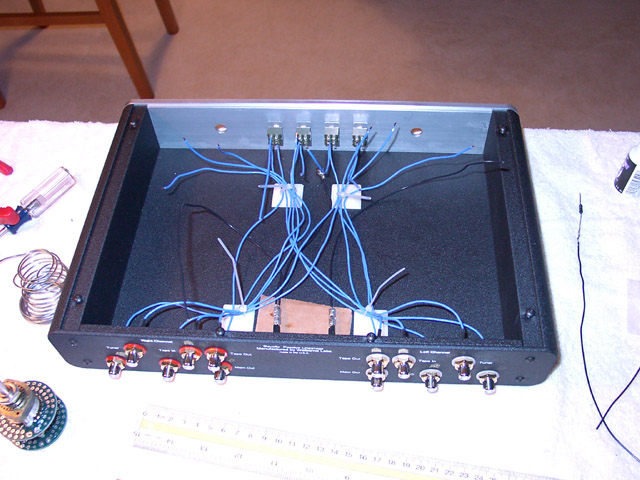
Above, the box is partially wired; this is before I finished the grounding changes.
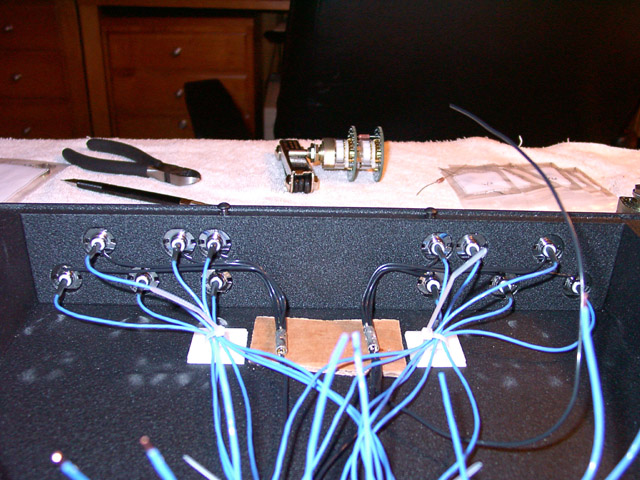
View of the back panel RCA connectors, which are Cardas silver rhodium.
The blue wires are Kimber silver hookup cable.
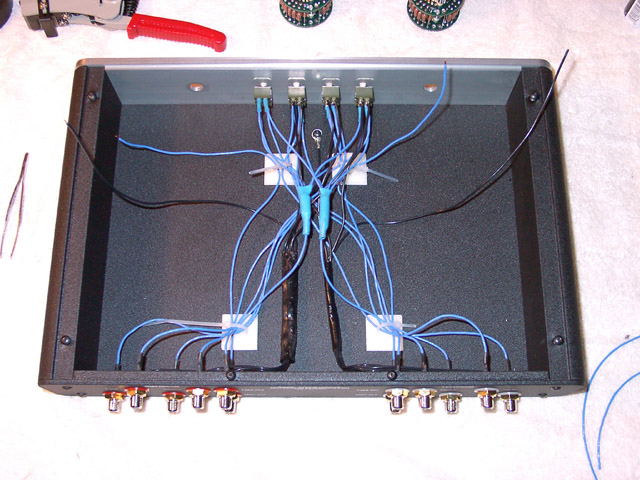
Above, I've completed the grounding wires and resistors.
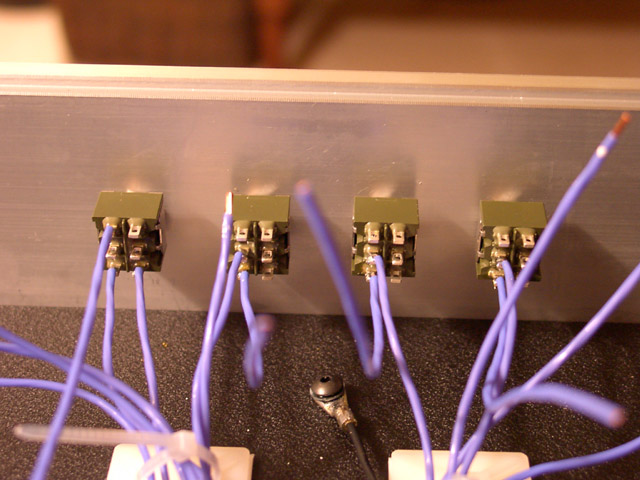
Above are the front panel selector switches at an early phase of construction.
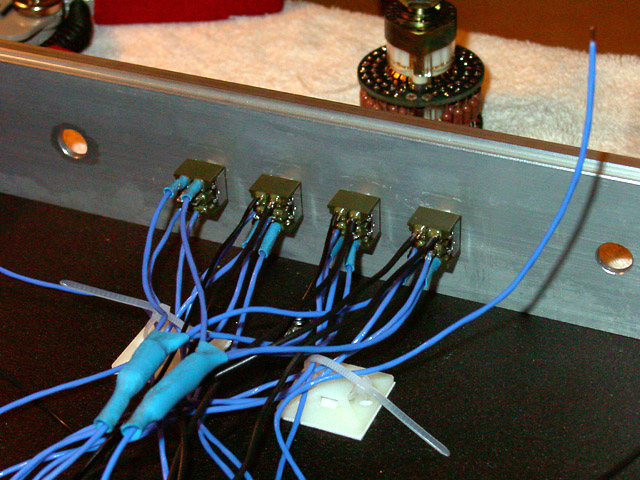
Here are the front panel switches fully completed.
Observe the big blue butt splices, which join the selected source wires together.
They go to the tape out, and to the attenuators (to the power amp).
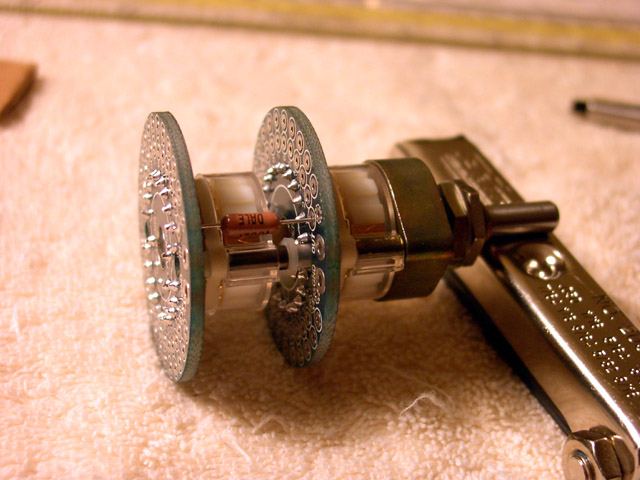
Above is one of the ladder stepped attenuators at an early phase of construction.
These are made in Switzerland and the USA by Goldpoint.
The resistors are Dale 1% metal film.
I hand matched each pair of resistors to better than 0.5% tolerance.
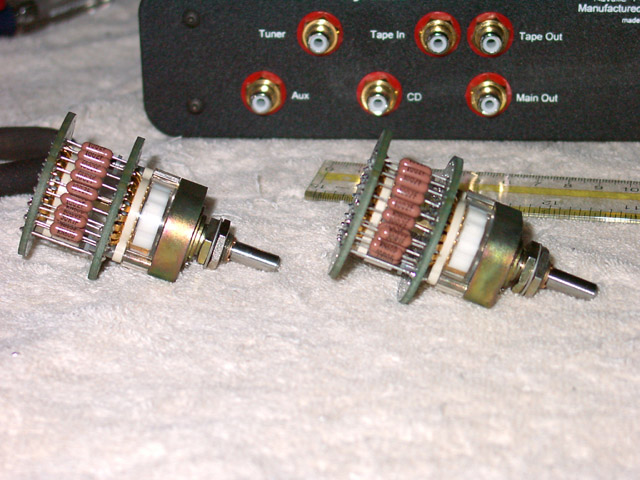
Above are the two attenuators, nearly completed.
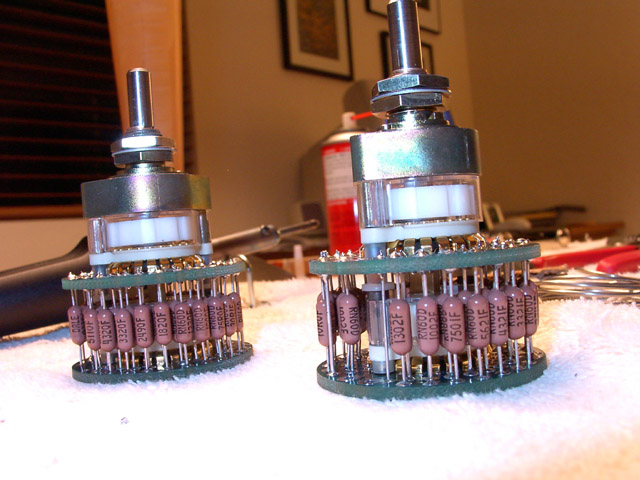
Above are the attenuators ready to install.
Each position has two resistors, each resistor has 2 connection points to solder,
and there are 24 positions on each attenuator,
so at this point I've made 192 careful solder connections.
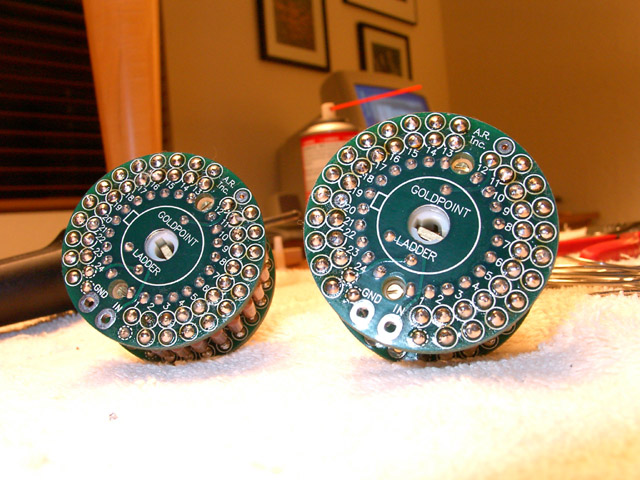
Another view of the attenuators.